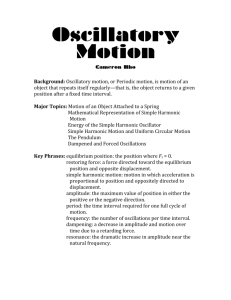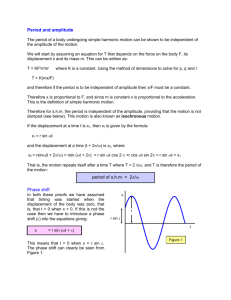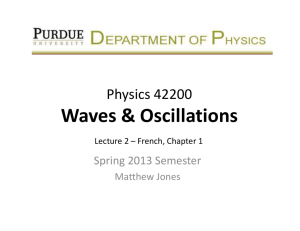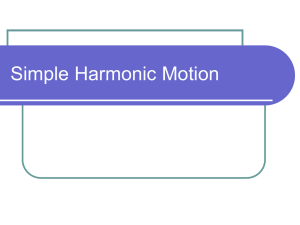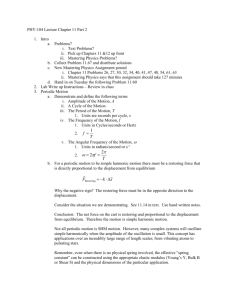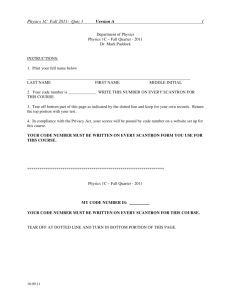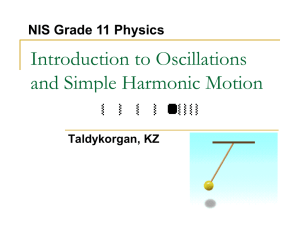Simple Harmonic Motion: Trig Equations & Applications
advertisement
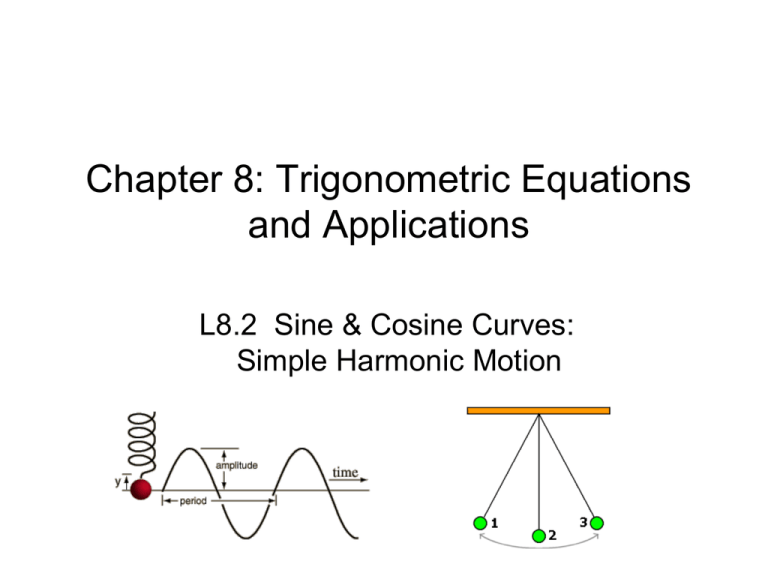
Chapter 8: Trigonometric Equations and Applications L8.2 Sine & Cosine Curves: Simple Harmonic Motion Simple Harmonic Motion The periodic nature of the trigonometric functions is useful for describing motion of a point on an object that vibrates, oscillates, rotates or is moved by wave motion. For ex, consider a ball that is bobbing up and down on the end of a spring. 10cm is the maximum distance that the ball moves vertically upward or downward from its equilibrium (at rest) position. It takes 4 seconds for the ball to move from its maximum displacement above zero to its maximum displacement below zero and back again. With ideal conditions of perfect elasticity and no friction or air resistance, the ball would continue to move up and down in a uniform manner. Motion of this nature can be described by a sine or cosine function and is called simple harmonic motion. For this particular example, the amplitude is 10cm, the period is 4 seconds, and the frequency is ¼ cps (cycles per second). Simple Harmonic Motion A point that moves on a coordinate line is in simple harmonic motion if its distance d from the origin at time t is given by either d = a sin ωt or d = a cos ωt where a and ω are real numbers such that ω > 0. The motion has amplitude |a|, period 2π/ω and frequency ω/2π. Ex 1: Write the equation for simple harmonic motion of a ball suspended from a spring that moves vertically 8 cm from rest. It takes 4 seconds to go from its maximum displacement to its minimum and back. What is the frequency of the motion? Since the spring is at equilibrium (d = 0) when t=0, we will use the equation d = a sin ωt. The maximum displacement from 0 is 8 cm and the period is 4 sec so amplitude = |a| = 8, period = 2π/ω = 4 → ω = π/2. Consequently the equation of motion is d 8 sin 2 t The frequency = ω/2π = (π/2)/(2π) = ¼ cycle per second. * Note that ω (lower case omega) is just a stand-in for the coefficient, B. Since time, unlike an angle, is not measured in π, ω frequently has π in it for cancelation purposes. Simple Harmonic Motion (cont) A point that moves on a coordinate line is in simple harmonic motion if its distance d from the origin at time t is given by either d = a sin ωt or d = a cos ωt where a and ω are real numbers such that ω > 0. The motion has amplitude |a|, period 2π/ω and frequency ω/2π. 3 Ex 2: Given the equation for simple harmonic motion d 6 cos t , 4 where d is in cm and t is in seconds, find: (a) the maximum displacement, (b) the frequency, (c) the value when t = 4, and (d) the least positive value for t for which d = 0. (a) Max displacement is amplitude, which is 6 cm (b) Frequency = ω/2π = (3π/4) / 2π = ⅜ cycle per second. 3 4 6 cos(3 ) 6 1 6 cm 4 3 3 3 3 5 (d) d (t ) 6 cos t 0 cos t 0 t , , ,... 4 4 4 2 2 2 (c) d (4) 6 cos The least positive value: 3 2 t t sec. 4 2 3

